Evaluation of Company’s Current Social Media and Viral Activity
Social media has become an essential part of a modern society built on opportunities provided by technological progress and instant communication. For businesses and organizations of all forms and sizes, social media has become an effective tool for promoting their products and building communication with consumers. However, the use of social media for the sole purpose of promoting products or services is a rather primitive approach that can potentially cause adverse outcomes. Therefore, the experts develop individual social media strategies for different companies depending on their goals. For business, the strategy mainly focuses on building the brand and its recognition, increasing audience coverage, promoting new products, or developing a company’s positive image. This report will explore the social media strategy of Emirates airlines, analyze its prominent points, and provide recommendations on areas that could be improved.
Emirates is one of the world’s largest airlines owned by an agency of Dubai’s government. As a form of business, Emirates airlines are acknowledged for its steady growth and well-developed infrastructure that supports the company’s high level of competitiveness and ability to position itself as a global carrier (Alanezi and Al-Zahrani, 2020). The company’s business strategy results from the collaborative effort of top management and employees, which allows a high quality of customer services and achievement of top position among airline services providers (Alanezi and Al-Zahrani, 2020). According to information provided on the company’s website, Emirates received the APEX 2021 Five Star Global Official Airline Rating that verifies customers’ satisfaction with provided services (Emirates, 2020b). Thus, the company’s business strategy mainly focuses on providing high-quality services using the latest modern technologies and strengthening its position as a global airline operator.
Therefore, considering the business strategy of Emirates airlines, the company’s social media strategy is focused on building brand recognition, promoting the services, and creating media content about travels and the inner life of the company. Emirates Airlines’ official accounts can be found on several social media, including Facebook, Twitter, YouTube, and Instagram. Thus, to conduct a thorough analysis of the company’s social media strategy, this report will evaluate each of its four official social media accounts, its content, and the level of engagement with the audience.
Facebook is prioritized over other social media platforms in Emirates airlines’ strategy due to its practical use. Compared to Instagram posts that mainly rely on visual components and tweets with characters limitation, Facebook offers a balanced way to engage with the audience and publish media content. The content published on Facebook carries both informational and promotional value. It could be characterized by clear branding of media content with pictures of flight attendants in the corporate uniform and aircraft painted in the colors of the flag of the United Arab Emirates. In most cases, the intent behind Emirates’ posts on Facebook is to motivate the audience to travel more frequently and choose Emirates airlines as a permanent travel companion.
First, to explore the general intent behind the company’s social media strategy on Facebook, the report will use an example of one of Emirates’ posts. The following post (Figure 1) features a company-owned image of a massive airplane colored with the company’s corporate colors with a short caption (Ready to take-off into the weekend, 2021). The caption is meant to motivate the audience to travel on weekends and choose Emirates airlines to increase the flow of passengers. However, the post could also be interpreted as a relatable component, implying that the audience should associate themselves ready to start the weekend with an airplane willing to take off.
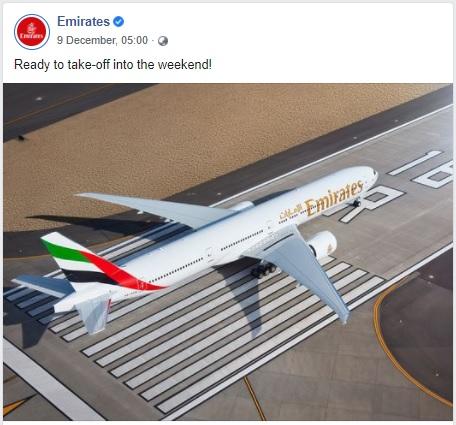
While at first glance, it is unclear what Emirates tried to achieve with this post, it presents one of several posts targeted at increasing the number of global travelers during the upcoming holiday season. According to Edmonds (2021), the travel forecasts suggest that Americans who had to cancel holiday trips last year due to the COVID-19 pandemic are more likely to travel during this holiday season. Therefore, there is a combination of people who decided to travel this holiday season and people who rescheduled their trips from the last year. The resulting combination of two flows is expected to cause a 34% increase in the number of traveling people during the upcoming holiday season (Edmonds, 2021). Thus, while Emirates airlines’ social media cannot directly sell vacation tours, their contribution to the dramatic increase of traveling people during this holiday season is motivating their followers to travel during holidays.
Within Emirates’ social media strategy, in addition to being acknowledged as a tool of communication with consumers, Twitter also presents a vital source of operational information for other stakeholders. Therefore, the original content published in the official Twitter account of Emirates airlines presents a summary of important news from the company. The brief news summary is followed by a link to the news article on the company’s official website.
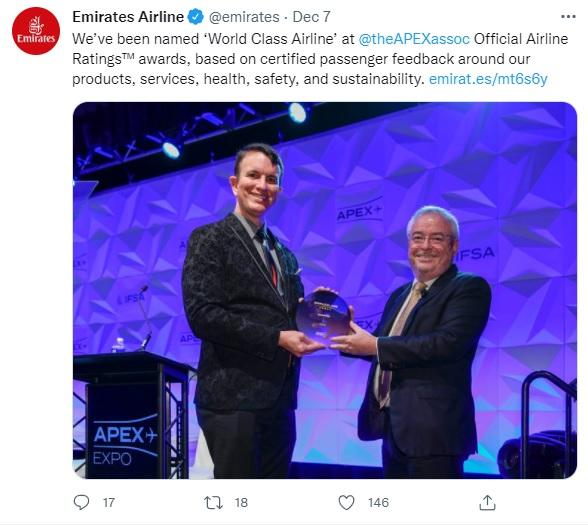
The following tweet (Figure 2) presents a substantial example of how Emirates’ social strategy perceives Twitter as a social platform with its unique features. The initial message behind the tweet is to provide a concise and compelling portion of the information that convinces the audience that Emirates offers high-quality services acknowledged for their safety and sustainability (Emirates Airline, 2021b). However, the tweet is intentionally formed in a way that eases the process of sharing the information. The tweet tags the official account of the Airline Passenger Experience Association (APEX). The audience can click to receive more information about the rating, certification, and the process of passengers’ feedback collection.
Thus, in Emirates airlines’ social strategy, Twitter presents a social platform used primarily to spread important news about the company. Each news article published on the company’s official website is also published on Twitter in brief form, simplifying the sharing process and attracting attention to Emirates’ main website. According to Kalsnes and Larsson (2018), the news-sharing process on social media significantly influences the way information is consumed, as sharing the content is acknowledged as a recommendation to read the initial article. Moreover, as the Twitter audience is more active and the platform implements algorithms that automatically show relevant tweets to a broader audience, the tweets also generate additional visits to Emirates’ main website. Thus, Emirates’ use of Twitter’s social media platform as an alternative to news outlets is effective and has an evidence base.
Instagram is a social media network characterized by several media opportunities, high engagement, and a solvent audience. In Emirates airlines’ social media strategy, the role of Instagram is not very prominent and lacks focus on one particular aspect. As the report mentioned earlier, Instagram is a social media platform that heavily relies on the visual component. The Instagram page of Emirates airlines features photos of aircraft, flight attendants, video infomercials, and coverage of events sponsored by the company. Overall, Emirates’ Instagram page is devoted to developing the brand image and increasing its recognition. However, while the content presents a high-quality product of the company’s efforts, it is very repetitive (Figure 3).
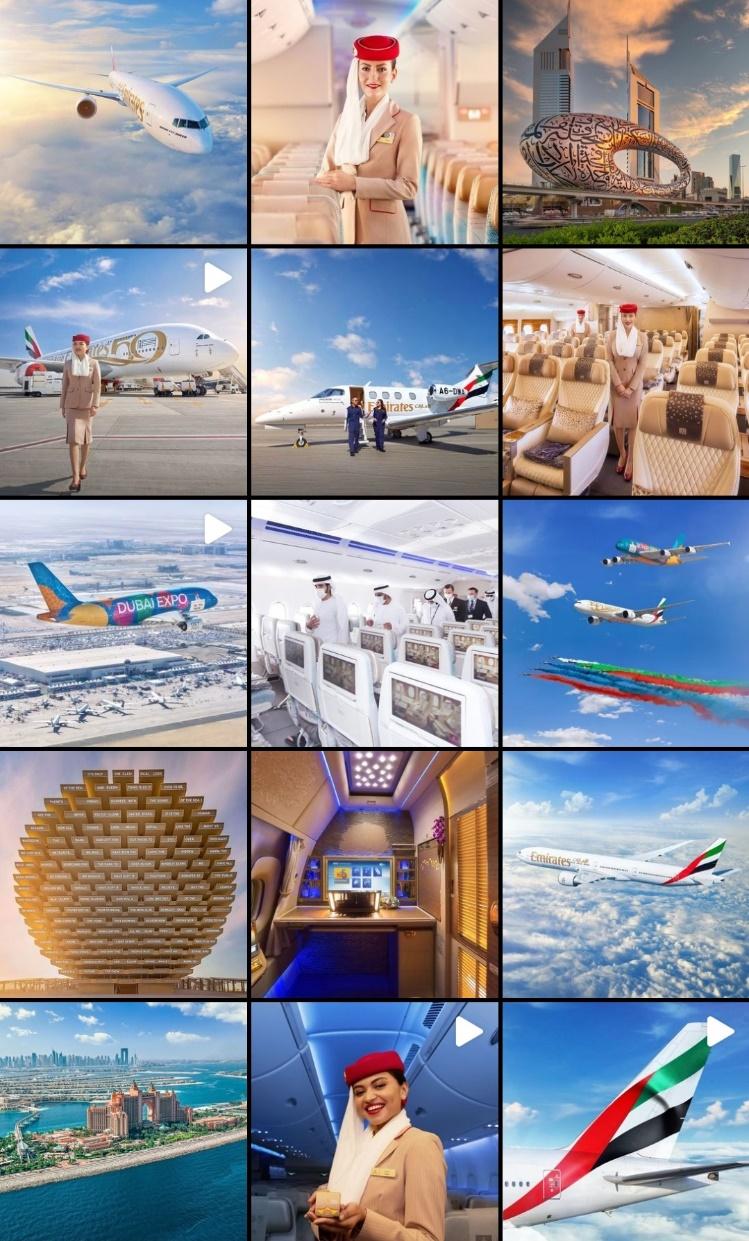
Instagram presents a relatively good foundation for viral content, compared to other social media such as Facebook, and has various built-in features that could be effectively used to adapt viral trends. However, from observing Emirates’ Instagram page, one could suggest that the brand positioned itself in limitations of being a serious company specializing in comfortable transportation of customers to their dream destinations. Significant attempts to create viral content were demonstrated on Emirates’ social media during the COVID-19 outbreak, where most of the population was forced to work from home and subject to social distancing restrictions. One of the significant examples is a video made by employees of Emirates dedicated to the celebration of Mother’s Day (2020c). Despite being filmed in unprofessional domestic settings, the video utilizes the elements of viral content fit to current social media content trends. The video shows how even in conditions where flights were limited and there was no possible way to increase sales, social media continued to develop the company’s positive image through relatable content.
YouTube
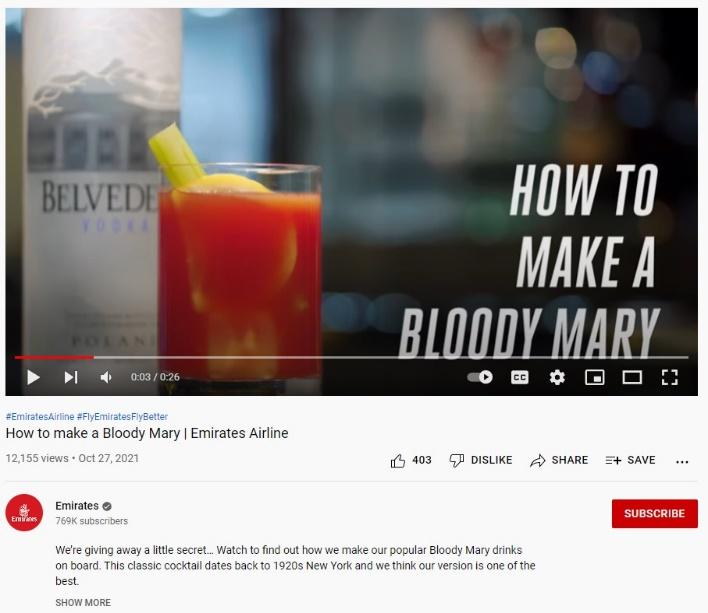
The Emirates’ YouTube page has the smallest number of followers across the company’s social media. Again, minor differences exist between content published on Emirates’ YouTube channel and their Instagram account. Most videos on Emirates’ YouTube page present short advertisements or infomercials. Occasionally, the company branches the content to a specific series designed to cover one topic, such as a series of Wine Experience videos or recipe videos for cocktails offered on Emirates Airlines’ boards (Emirates, 2020a; Emirates, 2021a). However, such series are unpopular and barely get 15-20 thousand views, which is relatively bad for an audience of more than seven hundred thousand subscribers (Figure 4 and 5).
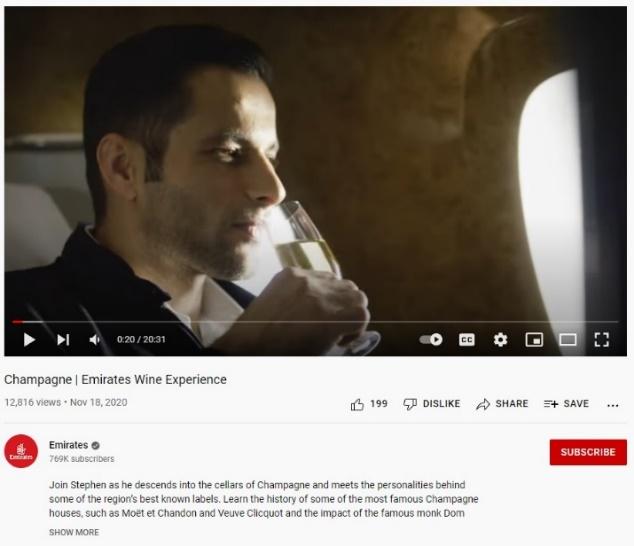
While it is understandable that the brand’s social media strategy focuses on creating the feeling of luxury, it misses the characteristics of its audience. One could suggest that luxury products-focused content is not interesting for Emirates’ audience, and the company’s social strategy misinterprets its following. On the other hand, the media content that focuses on the services provided by Emirates, such as cabin tour videos, has significantly more views.
Improvement/Recommendations
Based on the analysis conducted in the first part of the report, there were several problems and challenges identified in the social strategy of Emirates Airlines. First, the content published on every social platform is highly repetitive, with little room for exclusive content. Next, most of Emirates airlines’ publications on social media networks are owned by the company. Although the publications owned by the company represent high-quality content, social media lacks outside opinion and perspective on paid and earned components. Moreover, the social strategy does not consider the audience’s interests, focusing on the brand image and recognizability, even though that type of content is not appealing to the public. Lastly, Emirates’ social strategy does not utilize unique valuable features of each social media platform, which results in a deficiency of viral content.
Facebook: Motivating the Followers to Travel through Visual Stimuli
The analysis from the first part of the report determined that Facebook is Emirates’ prioritized social media platform. Facebook is the company’s primary source of communication with customers on social media. Compared to the company’s other official social media accounts on Twitter or Instagram, Emirates’ social strategy on Facebook utilizes a more friendly and relaxed approach. The content is tailored to followers’ interests to promote the company’s services and increase the airline’s ticket sales. The example discussed in the first part of the report focused on the use of motivating captions on the company’s aircraft photo. According to Leong et al. (2018), Facebook users are highly responsive to visual stimuli and experience a strong urge to purchase, which leads to a 61.7% possibility of impulse purchase. Therefore, the company’s social strategy uses the right approach in motivating the audience to travel more.
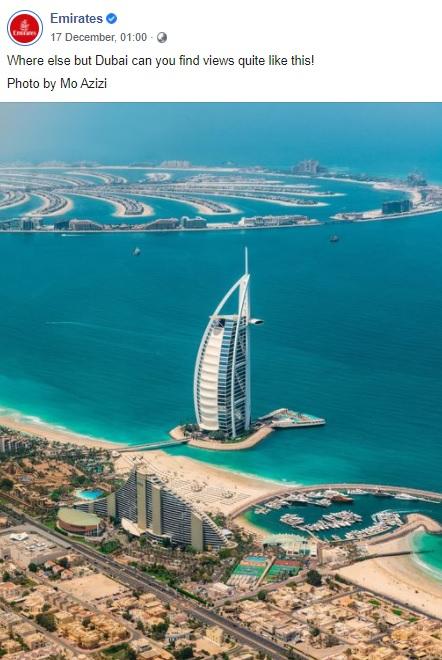
However, some aspects could serve as an improvement to the current social media strategy. For example, the following post (Figure 6) features a photo of one of the popular dream destinations in Dubai, which also is the company’s homeland (Emirates, 2021). The picture presents a single case of paid content on Emirates’ social media for a long time and provides credit to the original author. Studies suggest that the Facebook audience that spends more time browsing the platform is subjected to the influence of visual stimuli and is more inclined to urge to purchase (Leong et al., 2018). Through increased use of paid content with pictures of other dream destinations, the company could benefit from increased ticket sales and a higher number of traveling audiences.
Twitter: Increasing Earned and Paid Content
Firstly, as mentioned earlier in the report, in Emirates’ social media strategy, Twitter is acknowledged as a tool for sharing important information with stakeholders. However, the company’s presence on Twitter exhibits the same issue where most of the media content is owned and controlled by Emirates. In this case, stakeholders’ knowledge and awareness of the company’s image is limited to a single perspective, or narrative, controlled by the company. The earlier example of a Tweet from Emirates’ official account demonstrated how easy it is to share valuable information and provide links to important content. Increasing the number of PR publications from third-party sources could be used to diversify the content and offer an alternative perspective on the company’s services and state of business.
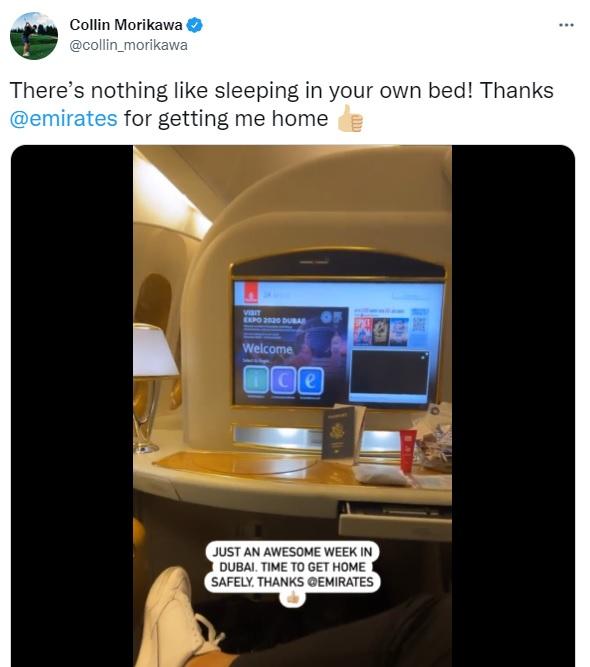
The decision to approach Twitter as a business-centered social media in Emirates’ social media strategy has an evidence base that supports its efficiency. According to Huang and Li (2021), Twitter is more related to business than Instagram, as the word cloud study showed that business-related terms are used more often on Twitter. Moreover, the study suggests that Twitter reviews for the business segment and services tend to be more positive. Therefore, the single issue that should be improved in Emirates’ future social strategy on Twitter is increasing the amount of paid and earned content.
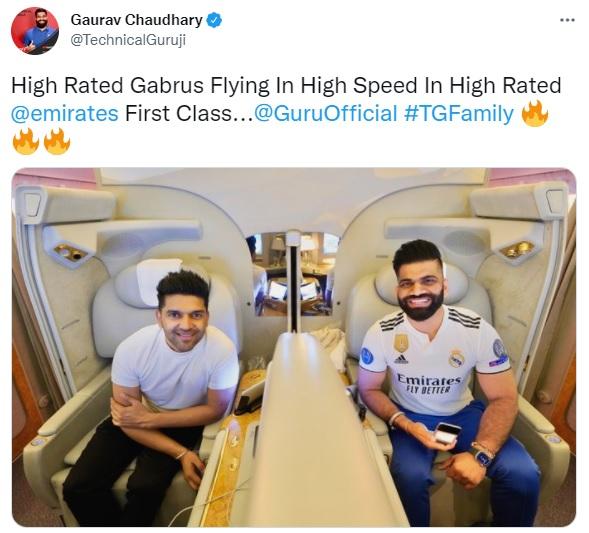
Increased interactions with consumers could efficiently resolve the issue of the low proportion of earned media content. Twitter as a social media can be characterized by the high speed of information spread. It utilizes a straightforward approach to the process of information sharing by reducing it to a single click or retweet. However, from analyzing the Emirates’ Twitter account, one could note that the retweet function is underused in the social media strategy, even though there are plenty of positive reviews from credible sources and clients of Emirates Airlines. For example, tweets from Colin Morikawa (Figure 7) and Gustav Chaudhary (Figure 8) have more likes than an average post from Emirates but were not featured or retweeted by the company. Simply retweeting tweets from customers would result in a significant increase in the proportion of earned content, defying the one-sided character of Emirates’ social media.
Instagram: Utilizing the Platform’s Unique Features to Create Exclusive Content
In the first part of the report, the analysis of Emirates’ official Instagram page defined that even though the content presents a high-quality product of the company’s efforts, the media is mostly owned by the company. Thus, the same recommendations that applied to Emirates’ Twitter account could be used to improve Emirates’ social strategy on Instagram. Moreover, the analysis showed that the media content on the Instagram page is highly repetitive, with similar photos of aircraft and flight attendants posted throughout several years. While the visual component of the company’s Instagram page utilizes a cohesive color palette, there is no message behind the posts that could speak to customers’ relatability with the branding. Lastly, the content circulates throughout Emirates’ accounts on social platforms.
Furthermore, compared to other social media platform users, Instagram users could be characterized as a younger audience expressing interest in environmental safety, sustainability, and social responsibility. According to Loukianov et al. (2020), the Instagram platform’s popular narratives rarely focus on promoting sustainability as a lifestyle, but users themselves encourage an understanding of sustainable living. Besides providing luxury services, Emirates utilizes an extensive sustainability policy to reduce the environmental impact of the company’s services. Instagram’s additional features, such as Reels and IGTV, could act as a base for creating Instagram-exclusive content focused on the company’s contribution to environmental safety. For example, as one of the sustainability measures, the company utilizes a water-saving “drywash” procedure on the aircraft’s exterior, allowing water-saving and reducing fuel consumption (Emirates, n.d.). Filming a series of videos designed to showcase Emirates’ focus on sustainability and modern environmentally friendly technologies in operations (Figure 9) will help build the brand’s positive image and justify high ticket prices.
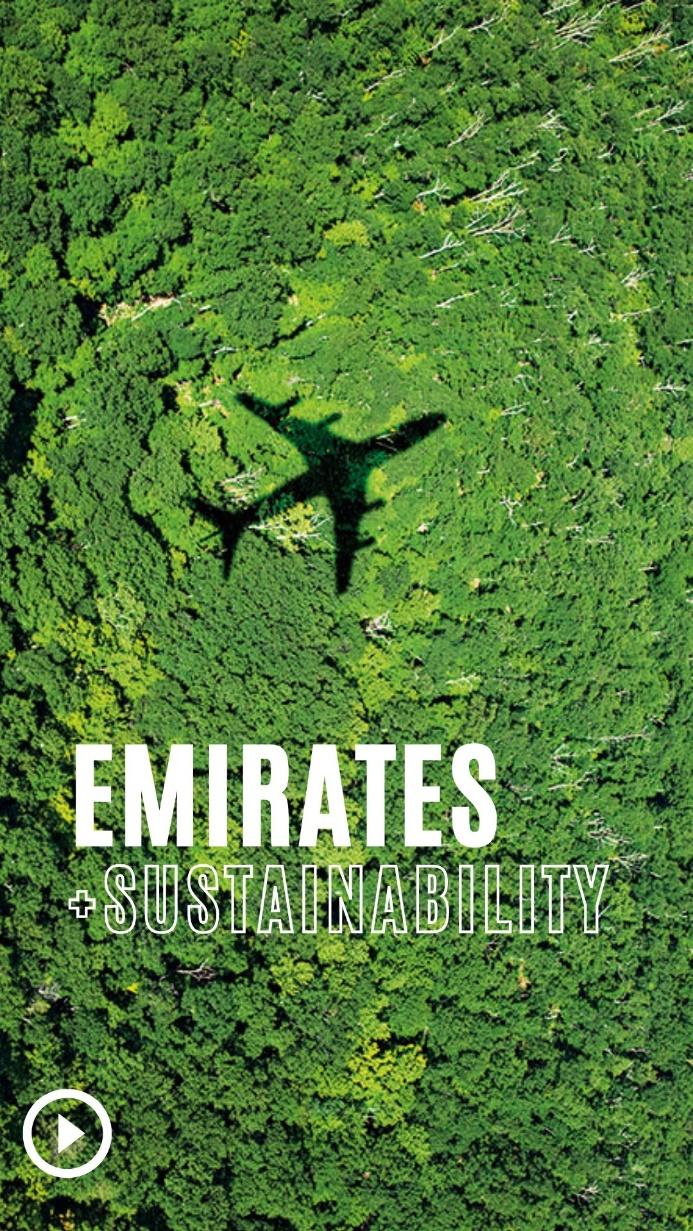
YouTube: Prioritizing Audience’s Interests
The analysis of Emirates’ YouTube channel conducted in the first part of the report identified one significant issue in the company’s social strategy: misinterpretation of the audience’s interests. The company makes significant efforts to support the luxury feeling of its services with videos that center on the premium experiences such as wine tasting and cocktails recipes. However, videos dedicated directly to introductions to new or existing aircraft gain significantly more views. Therefore, the content of the YouTube channel should be adapted to the audience’s interests.
In order to appeal more to the audience that expresses interest in purely technical aspects of Emirates’ work, the content of the company’s YouTube channel could focus more on the aircraft and their unique features. One of the most popular videos on Emirates’ YouTube channel is a virtual tour of the interior of one of Emirates’ airplane, which appeals more to entertainment and curiosity purposes. Utilizing the views data that defines the audience’s interest will significantly increase views and brand recognition. An excellent example of video content that will appeal to the existing audience will be a video review of five of the company’s most unique aircraft boards with a duration of three to five minutes (Figure 10).
Furthermore, another significant aspect in building the brand’s recognition is the content’s appeal to the platform’s algorithms. On average, videos with attractive thumbnails and relevant keywords such as ‘top five’ and ‘top 10’ in the title tend to gain more views (more than one million) with the help of YouTube algorithms (Moore, 2021). Moreover, according to Peterson (2018), longer videos with a duration of 12 to 14 minutes are more appealing to the platform’s audience. However, due to increased repetitions across different social media platforms, most of the content on Emirates’ YouTube page is duplicated from Instagram. As opposed to YouTube, Instagram algorithms favor shorter videos filmed in a square aspect ratio. Converting the content catered to one social platform results in limited opportunities for the social strategy in building the brand recondition.
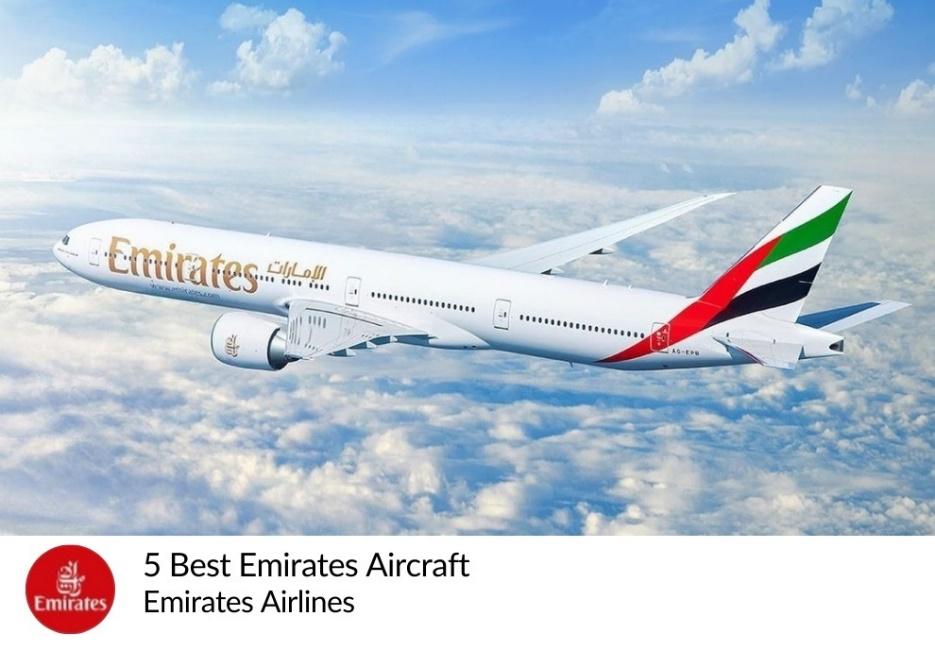
In conclusion, the report should evaluate and acknowledge Emirates’ latest efforts in viral content. The report explored Emirates’ first attempts in viral content with the video for the Mother’s Day celebration. However, the creative intent behind the video was inspired by a video from British Airways (BA Pilots Thank You, 2020). On the other hand, Emirates’ recent video called We’re on top of the world accumulated more than 6 million views on the official YouTube channel (Emirates, 2021c). The viral advertisement sparked many discussions in media outlets about its creativity (Jain, 2021). However, using YouTube as the primary platform for the ad sufficiently reduced its coverage. According to suggestions from marketing researchers, TikTok’s social platform and its algorithms have more exposure potential (Halpern, 2021). Thus, recently Emirates’ social strategy started generating creative ideas for viral content, and the choice of social media for publication was faulty.
Reference List
Alanezi, F. and Al-Zahrani, R. (2020) ‘Strategic management of Emirates airlines’, Proceedings of the 2020 2nd Asia Pacific Information Technology Conference, pp. 172-177.
Chaunhary, G. (2021) [Twitter] Web.
Disney and Universal Parks (2020) BA Pilots Thank You. Web.
Edmonds, E. (2013) ‘Tis the season: More than 109 million Americans to travel for the holidays. Web.
Emirates. (n.d.) Sustainability in operations. Web.
Emirates (2020a) Champagne: Emirates wine experience. Web.
Emirates. (2020b) Emirates earns five-star rating from its customers. Web.
Emirates. (2020c) Happy Mother’s Day wishes from our flying moms to all mothers near and far. Web.
Emirates (2021a) How to make a Bloody Mary: Emirates Airline. Web.
Emirates Airlines. (2021b) [Twitter] Web.
Emirates (2021c) We’re on top of the world. Web.
Halpern, I. Why you should be using TikTok for business in 2021. Web.
Huang, G. and Li, Y. (2021) ‘Which platform is better for business: Instagram VS Twitter’, Advances in Social Science, Education and Humanities Research, 607, pp. 1064-1068.
Jain, S. (2021) Was this viral Emirates ad really filmed on top of Burj Khalifa? Web.
Kalsnes, B. and Larsson, A. O. (2018) ‘Understanding news sharing across social media’, Journalism Studies, 19(11), pp. 1669-1688.
Leong, L.Y. et al. (2018) ‘The effects of Facebook browsing and usage intensity on impulse purchase in f-commerce’, Computers in Human Behavior, 78, pp. 160–173.
Loukianov, A. et al. (2020) ‘Young people, good life narratives, and sustainable futures: the case of Instagram’, Sustainable Earth, 3, pp. 1-14.
Moore, C. (2021) How to rank business videos on the top of YouTube (Case Study). Web.
Morikawa, C. (2021) [Twitter] Web.
Peterson, T. (2018) Creators are making longer videos to cater to the YouTube algorithm. Web.
Ready to take-off into the weekend! (2021) [Facebook] Web.